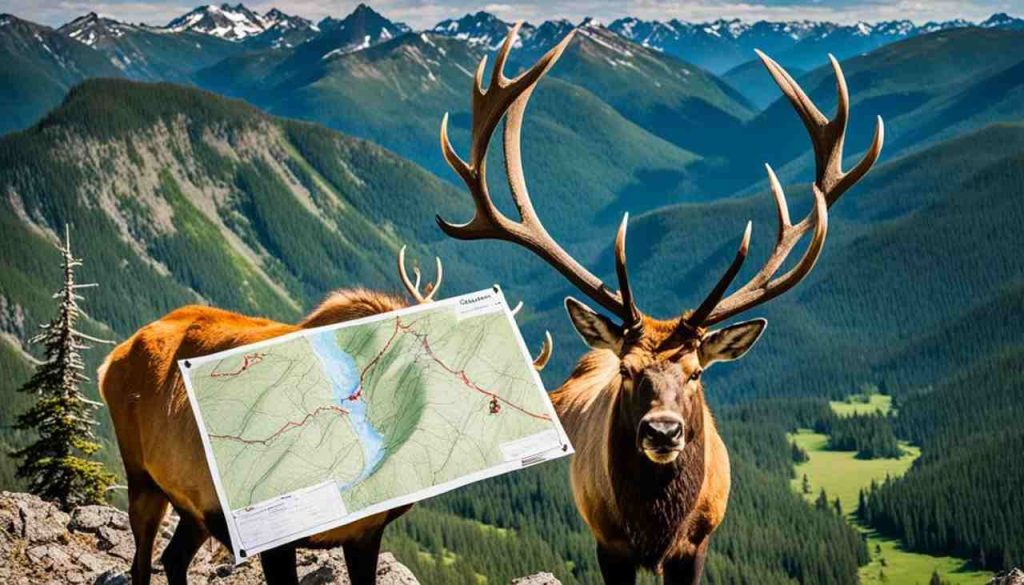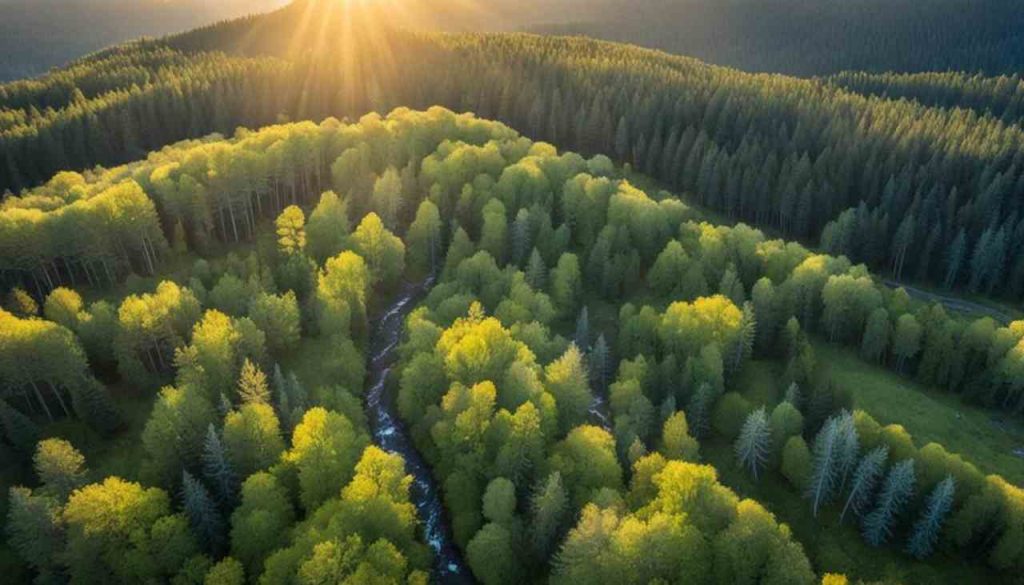Did you know – 92% of successful elk hunters scout before the season? As someone who loves elk hunting, I believe getting ready well is key. To be great at finding trophy elk, you need to know their habits, where they live, and how they act.

This guide will give you all my tips from many years of hunting. It will help you get better at finding elk and have more success during the hunt.
The Importance of Pre-Season Scouting
For elk hunters like me, pre-season elk scouting is very important. Knowing elk migration paths and elk habitats is key to hunting success. I find trail cameras for elk extremely helpful in my scouting work.
Understanding Elk Migration Patterns
Their migration changes with the seasons. In spring, elk follow the snow melt up to higher lands. They move towards new green grass. Knowing where they go in spring and summer is crucial. This way, we can find them easily depending on whether they are bachelor bulls or calving cows.
Identifying Key Habitats
Good pre-season elk scouting means finding places with lots of food, water, and hiding spots. It’s important to do your homework and pick out areas that have what they need to live. This could be good meadows, safe bed places, or places with a lot of water. Knowing about their habitats helps us find these beautiful animals.

The Value of Trail Cameras
Trail cameras for elk are a hunter’s best friend. Placing these cameras near water, trails, or feeding areas can show us where they are moving. They also allow us to find spots where lots of elk gather. This is key in finding where the big bulls are going during the rut in September.
Researching Your Hunting Area
When looking into hunting area research, I mix digital sources and expert tips. I always check the land on Google Earth first. This helps me find spots elk love, with food, water, and places to hide.

Still, advice from local biologists is key. They know a lot about elk and where they move. I always talk to them to find the best spots and plan well.
Considering Private Land Proximity
I think about private land refuges a lot. Elk go there for safety sometimes. Knowing about these lands helps me hunt smarter, watching where the it might go.
Utilizing Online Resources
Besides Google Earth, I search forums and talk to other hunters. They share tips that tell me where the best places to hunt are. And they warn me about busy spots or problems I might face.
Contacting Local Biologists
Talking to local biologists helps with big facts, like how many elk are around or how hard it is to hunt. This helps me understand my chances and where I should go to hunt.
Physical Scouting: Boots on the Ground
E-scouting is great for a first look at elk scouting spots. But nothing beats heading out in-person elk scouting. Walking and exploring the land helps spot real clues. These can really help in finding and understanding these amazing creatures.
Scouting for Elk Sign
Observing well is critical when in-person elk scouting. Look for clear signs such as wallows, trails, rubs, and droppings. These show recent activity and help you understand their patterns. Knowing this can improve your game strategies.
Locating Cow Elk Herds
Locating cow elk groups is very important during in-person elk scouting. In the summer, these female herds set their home areas. Finding where they are can help locate the bulls during the rut. Knowing where the female elk are helps you find the male elks during mating season.
Look in areas with lots of different plants for elk cows. They like places with many food and hiding spots. Also, watch for land shapes like ridges and draws. These can guide their movement and are good places to track and wait for them.
| Sign | Description | Significance |
|---|---|---|
| Wallows | Muddy depressions where elk roll and coat their bodies with scent | Indicates recent activity and potential travel routes |
| Trails | Well-worn paths through vegetation, often leading to water sources | Reveals heavily trafficked areas and movement patterns |
| Rubs | Trees or bushes where antlers have rubbed against bark, stripping it | Signals the presence of bulls shedding velvet or marking territory |
| Droppings | Elk scat, often in large piles or scattered along trails | Confirms recent elk presence and can indicate herd size |
When you really pay attention to these signs during in-person elk scouting, you get to know a lot about these creatures. This knowledge will help you have a great pursuing season.
Effective Elk Scouting Strategies: How to Find Your Trophy
Being an elk hunter, I know great trophy elk scouting strategies are key. They help me find and hunt mature bulls. In summer, scouting well makes my fall hunts much better. I find the places where they gather.
One good method is calling tactics from high points. By using bull bugles and cow calls, I learn a lot. This technique lets me find active bulls. It offers clues about their movements and where they rest. In the rut, cow calls help draw in the breeding bulls.
Understanding herd dynamics is also crucial. Knowing about dominant and satellite bulls helps. Spotting areas with many cows means finding the bulls easier during the rut. Having the right elk hunting setup is vital too. It includes clear shooting lanes and routes for the bulls.
- Locate areas with a strong cow elk presence during the summer.
- Use a variety of calling tactics, including estrous cow calls during the rut.
- Scout for herd dynamics and identify potential travel routes for bulls.
- Set up pursuing spots with clear shooting lanes and easy bull access.
Using these trophy elk scouting strategies helps me meet mature bulls more. Detailed scouting, good calling tactics, and the right hunting setup are crucial. They are the core of my hunt for trophy elk every year.
Factors to Consider When Scouting
Being an elk hunter means you must understand their behavior. Knowing about elk velvet shedding is key. It changes bull elk behavior a lot.
Velvet Shedding and Bull Behavior
In late summer and early fall, bull elk shed their velvet. This marks the start of the breeding season. They become more aggressive and want their space. As the velvet falls off, they focus on being the boss and attracting female elk.
Hunting Pressure and Elk Movement
Hunting pressure affects where elk move. As season starts, this animals may change where they go a lot. So, it’s good to look at different places and be ready to change your plan.
They know when hunters are close and often go to private land to stay safe. It’s smart to know the limits of private land and whether elk might move there. This can give you an edge.
Prioritizing Multiple Areas
Their behavior can change quickly. It’s good to have several scout areas ready. Things like weather, hunting, or wildfires might force elk to leave their usual spots.
- Scout multiple drainages and basins to identify potential alternative locations.
- Prioritize areas with ample food sources, water, and cover to sustain elk herds.
- Monitor trail camera footage and fresh sign to adapt your strategy as needed.
Thinking about shedding velvet, hunting pressure, and where to scout helps a lot. It makes your scouting work better. You have a better chance of finding elk if you’re prepared for these things.
Conclusion
Being a big fan of elk hunting, I know that getting ready and looking around a lot help a lot. You must learn where they go, pick important spots, and use good calls and hunting ways. This makes finding and taking down big elk more likely. Knowing how to look around well is what top hunters do.
It’s key to be ready for different situations, like when elks lose their velvet, and when there’s too many people hunting. It’s smart to have a few extra places in mind. This lets you change your game plan if needed. Remember, spending lots of time in your hunting area and visiting it for a few years makes you really wise about the target.
To really be great at finding elk, you need to study up, look around a lot, and be ready all the time. Getting out there early, checking out new spots during the day, and using clever tricks like running and using the right calls can help a bunch. Doing all these things over and over makes you a top hunter. This shows how important getting ready and looking around a lot is to snagging a great elk.
- 2025 Connecticut Hunting: New Season Dates, Licenses & More! - May 15, 2025
- 2025 Arkansas Hunting Season New Dates & Rules - May 14, 2025
- 2025 Texas Hunting Season: Latest Dates & New Laws! - March 14, 2025

